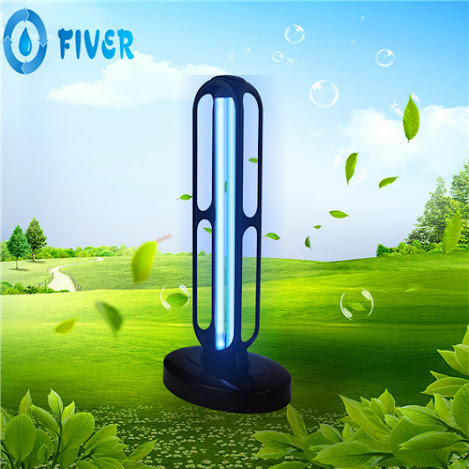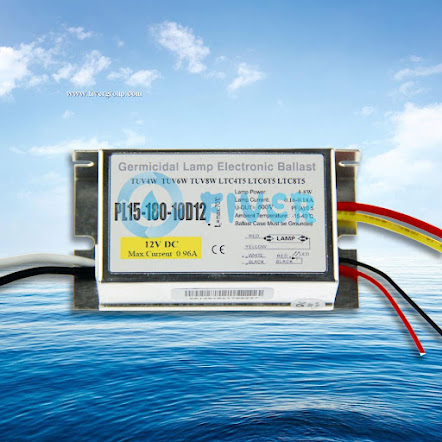How Long Does It Take for UV Light to Kill Bacteria?
Ultraviolet (UV)
light was first discovered in the mid-20th century, introducing a new
way for people to eliminate viruses and bacteria. Although UV technology has
risen to prominence in recent years, especially during the current COVID-19
pandemic, the majority of the general public does not fully understand exactly
how UV lighting helps kill viruses and bacteria. The following article will
shed light (pun intended) on how UV light works, what UV-C products and equipment
are available on the market, and the precautions that need to be taken to avoid
exposure to human skin.
Types of UV light
UV light is divided into several ranges: UV-A, UV-B, UV-C
(close to the visible light range) and Vacuum-UV (close to the x-ray range).
The UV-C light range is the only one able to destroy germs. It is found in UV
water purifiers, used in fish tanks, and in portable UV light sanitizers
designed to destroy germs that may exist on your tech gadgets and other regular
household items. UV-C light can fracture the molecular bonds of the viruses’
and bacteria’s DNA, affecting their ability to reproduce and ultimately killing
them.
UV light is one of the seven sections that make up the
electromagnetic spectrum. Lower frequencies are radio waves, microwaves, and
infrared (IR). These are harmless to humans and animals. A mid-range frequency
that many are familiar with is visible light. Ultraviolet (UV), X-rays, and
gamma-rays are the highest frequencies and can be very harmful to humans if
used without implementing appropriate safety measures.
How Does UV Light Kill Bacteria?
As mentioned above, the 3 major types of UV radiation are
UV-A, UV-B, and UV-C. UV-C rays can effectively eliminate bacteria and viruses
as they have the shortest wavelength of the 3 major UV rays. Their short
wavelength of 200 - 400 nanometers (nm) means that they have the highest
energy, allowing them to kill deadly pathogens. How does UV radiation primarily
kill microbes? UV-C light fractures the molecular bonds of the viruses and
damages the DNA of microbes and bacteria, affecting their ability to reproduce
and ultimately killing them. It has also been known to destroy “superbugs”,
whose resistance to antibiotics makes them notoriously hard to eliminate. The
efficacy of UV-C lighting has seen many people look to it as a means to kill
the coronavirus by decontaminating surfaces and objects on which the virus may
be present.
How long does it take for UV light to kill viruses?
Studies conducted by researchers at John Hopkins University
using UV light on “high touch” public spaces in hospitals such as bed rails,
tray tables, and vitals monitors have revealed that it only takes 15 minutes
for these objects to be disinfected using UV light. Remarkably, the study
revealed 25 out of 27 high-touch surfaces used in the study were devoid of any
bacteria after being exposed to UV light. To destroy bacteria, ultraviolet
radiation is used as a disinfectant by utilizing a 200 to 300 nanometre range.
To eradicate a virus, extremely high levels of UV light would be required and
the amount of UV required and the time needed would be dependent on many
factors, such as the shape and type of material that the virus is found on.
Current UV devices are insufficient to adequately kill viruses. Efforts are
being made to create a portable UV device that is capable of releasing
high-intensity rays able to kill viruses, such as the SARS-CoV-2 virus.
UV-C lights are available to consumers in a variety of
different products including UV-C lamps and wands. The length of time needed to
destroy viruses and bacteria is unique to each device. Each UV-C device will
state on the packaging or the packaging insert how long it will take to
sanitize the product and how close the object will need to be held to the
device. UV light is only effective on smooth, flat surfaces and cannot
effectively disinfect rounded objects such as the buttons of a remote control,
nor can it get into crevices. Other forms of disinfection would be required to
adequately clean these objects.
How Does UV Radiation Affect the Growth of Viruses?
A virus’s exposure to radiation is believed to subdue
cell-mediated immunity, which may affect the course of a viral infection. As
previously mentioned, UV-C possesses the ability to critically destroy a virus’s
molecular bonds, inhibiting the virus from multiplying and becoming a threat to
humans. Sunlight, particularly UV radiation, is the main natural virucide that
exists in our environment. UV radiation destroys viruses by chemically changing
their genetic makeup. The most efficient wavelength to bring about inactivation
is 260nm. The nucleic acids within viruses can be harmed by UV-A and UV-B
radiation, however, they are not as effective and potent as UV-C.
UV-C Products and Equipment
The growing popularity of UV radiation has seen it being
used in a variety of products such as UV germicidal lamps, and water filters.
Recent developments have helped to place UV technology in portable wands that
may be easily transported. Because of this, it is being used in a variety of
environments, from hospitals to households. The large variety of objects that
UV products can disinfect include, but are not limited to: surfaces, paper
goods, water, air, toys, household objects, tech devices, and even fresh
produce.
Not all UV-C products being advertised are genuine,
therefore it is important to do sufficient research before committing to buying
a specific product. Counterfeiters are looking to make a quick dollar at a time
when UV-C product sales are soaring. Ensure that you have purchased your
product from a reputable source. This can be done by checking the reviews of
the product that you are intending to buy and doing a quick search of the
company online to ensure their credibility.
To determine whether or not a UV light is working
properly:
1.Hold a white object up to the light - UV light will
clearly irradiate color found on the violet spectrum. However, this cannot be
seen by the naked eye. In order to see this violet color, an object lacking in
pigment needs to be held up to the light such as a white piece of paper or a
sock.
2.Closely monitor the item - If the majority of the
item turns a violet shade, it means that the UV bulb is functioning the way it
is meant to. If the object is still largely white, this might mean that the UV
bulb is defective.
3.If you remain unsure - Move the bulb to another
light fixture and repeat the test. If the test fails the second time around,
you are most likely dealing with a defective or fake UV light.
UV Safety and Precautions
The correct safety precautions must be taken when handling
UV radiation, specifically UV-C as it is the strongest form of ultraviolet
radiation. Overexposure to UV-C may cause sunburn or even skin cancer. After
purchasing a UV-C product, make sure that it is installed and configured in a
way that blocks exposure of the rays to any humans and animals. Stringent
safety measures are particularly important as UV-C rays are invisible which
increases the chance of accidental exposure. Materials and objects that may be
present in the home and workplace such as houseplants, wood, and plastic may be
damaged from accidental exposure to UV radiation.
Conclusion



Comments
Post a Comment